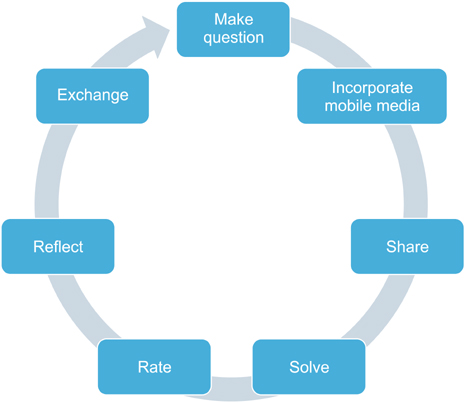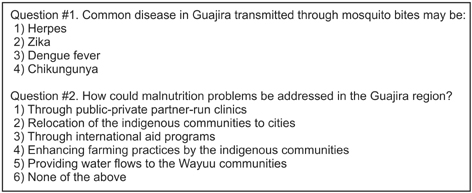Healthc Inform Res.
2016 Jul;22(3):164-171. 10.4258/hir.2016.22.3.164.
New Evaluation Vector through the Stanford Mobile Inquiry-Based Learning Environment (SMILE) for Participatory Action Research
- Affiliations
-
- 1Graduate School of Education, Stanford University, Stanford, CA, USA. phkim@stanford.edu
- 2u-Healthcare Design, Design Institute, Inje University, Seoul, Korea.
- KMID: 2357394
- DOI: http://doi.org/10.4258/hir.2016.22.3.164
Abstract
OBJECTIVES
This article reviews an evaluation vector model driven from a participatory action research leveraging a collective inquiry system named SMILE (Stanford Mobile Inquiry-based Learning Environment).
METHODS
SMILE has been implemented in a diverse set of collective inquiry generation and analysis scenarios including community health care-specific professional development sessions and community-based participatory action research projects. In each scenario, participants are given opportunities to construct inquiries around physical and emotional health-related phenomena in their own community.
RESULTS
Participants formulated inquiries as well as potential clinical treatments and hypothetical scenarios to address health concerns or clarify misunderstandings or misdiagnoses often found in their community practices. From medical universities to rural village health promotion organizations, all participatory inquiries and potential solutions can be collected and analyzed. The inquiry and solution sets represent an evaluation vector which helps educators better understand community health issues at a much deeper level.
CONCLUSIONS
SMILE helps collect problems that are most important and central to their community health concerns. The evaluation vector, consisting participatory and collective inquiries and potential solutions, helps the researchers assess the participants' level of understanding on issues around health concerns and practices while helping the community adequately formulate follow-up action plans. The method used in SMILE requires much further enhancement with machine learning and advanced data visualization.
Keyword
MeSH Terms
Figure
Reference
-
1. Lykes MB, Hershberg RM. Participatory action research and feminisms: Social inequalities and transformative praxis. In : Hesse-Biber SN, editor. Handbook of feminist research: theory and praxis. 2nd ed. Thousand Oaks (CA): Sage Publications;2012. p. 331–367.2. Fournier B, Mill J, Kipp W, Walusimbi M. Discovering voice: a participatory action research study with nurses in Uganda. Int J Qual Methods. 2007; 6(1):1–19.
Article3. Minkler M, Wallerstein N. Community based participatory research for health. San Francisco (CA): Jossey-Bass;2003.4. De Koning K, Martin M. Participatory research in health: issues and experiences. London: Zed Books;1996.5. Baum F, MacDougall C, Smith D. Participatory action research. J Epidemiol Community Health. 2006; 60(10):854–857.
Article6. Welbourne A. Gender, participation and HIV: a positive force for change. In : Guijt I, Shah MK, editors. The myth of community: gender issues in participatory development. London: Intermediate Technology Publications;1998. p. 131–140.7. Harvey I, Schulz A, Israel B, Sand S, Myrie D, Lockett M, et al. The Healthy Connections project: a community-based participatory research project involving women at risk for diabetes and hypertension. Prog Community Health Partnersh. 2009; 3(4):287–300.
Article8. Allen D, Hutchinson T. Using PAR or abusing its good name? The challenges and surprises of PhotoVoice and PAR in a study of chronic illness. Int J Qual Methods. 2009; 8(2):115–128.
Article9. Kralik D, Koch T, Eastwood S. The salience of the body: transition in sexual self-identity for women living with multiple sclerosis. J Adv Nurs. 2003; 42(1):11–20.
Article10. Welbourne A. Participatory approaches to HIV/AIDS programmes. PLA Notes. 1995; 23:57–80.11. Rhodes SD, Eng E, Hergenrather KC, Remnitz IM, Arceo R, Montano J, et al. Exploring Latino men's HIV risk using community-based participatory research. Am J Health Behav. 2007; 31(2):146–158.
Article12. Coker-Appiah D. The CEDAW convention and harmful practices against women: the work of the CEDAW Committee. New York (NY): United Nations;2009.13. Doane GH, Varcoe C. Family nursing as relational inquiry developing health promoting practice. Philadelphia (PA): Lippincott Williams & Wilkins;2004.14. Blumenthal D. Stimulating the adoption of health information technology. N Engl J Med. 2009; 360(15):1477–1479.
Article15. Fernandez-Luque L, Bau T. Health and social media: perfect storm of information. Healthc Inform Res. 2015; 21(2):67–73.
Article16. Buckner E, Kim P. Integrating technology and pedagogy for inquiry-based learning: the Stanford Mobile Inquiry-based Learning Environment (SMILE). Prospects. 2014; 44(1):99–118.
Article17. UNESCO Information Services Section. ICT in education [Internet]. Paris: UNESCO;c2016. cited at 2016 Jul 1. Available from: http://www.unesco.org/archives/multimedia/?s=films_details&pg=33&id=2958.18. SMILE UNESCO presentation by Paul Kim [Internet]. [place unknown]: SlideShare;c2016. cited at 2016 Jul 1. Available from: http://www.slideshare.net/SMILE_Consortium/smile-talk?qid=29cbb6f1-72f4-40de-bbc1-a639a4795c2c&v=&b=&from_search=3.19. De Cooman R, De Gieter S, Pepermans R, Du Bois C, Caers R, Jegers M. Freshmen in nursing: job motives and work values of a new generation. J Nurs Manag. 2008; 16(1):56–64.
Article20. Wong LP, Tan HM, Low WY, Ng CJ. Traditional and complementary medicine (T/CM) in the treatment of erection difficulties–experience from the Asian Men's Attitudes to Life Events and Sexuality (MALES) study. J Mens Health. 2008; 5(4):356–365.
Article21. Fry L, Santos YE, Zhang Y. Health information use: preliminary results from a systematic review. Proc Assoc Inf Sci Technol. 2015; 52(1):1–3.
Article22. Pepe MV, Sanders DW, Symons CW. Sexual behaviors of university freshmen and the implications for sexuality educators. J Sex Educ Ther. 1993; 19(1):20–30.
Article23. Ouzounian M, Hassan A, Teng CJ, Tang GH, Vanderby SA, Latham TB, et al. The cardiac surgery workforce: a survey of recent graduates of Canadian training programs. Ann Thorac Surg. 2010; 90(2):460–466.
Article24. Jordon M, Lanham HJ, Anderson RA, McDaniel RR Jr. Implications of complex adaptive systems theory for interpreting research about health care organizations. J Eval Clin Pract. 2010; 16(1):228–231.
Article25. Kim P. Future education ecosystem. Paris: UNESCO;2011.26. Kim P. It's time to flip the classroom [Internet]. [place unknown]: wise ed.review;2016. cited at 2016 Jul 1. Available from: http://www.wise-qatar.org/paul-kimflipped-classrooms-stanford.27. Kim P. Inquiry based public health education in Buenos Aires, Argentina. Stanford (CA): SMILE;2012.28. Kim P. Inquiry based public health education in La Guajira, Columbia. Stanford (CA): SMILE;2013.29. Kim P. Inquiry based medical education in Chungbuk National University, Korea. Stanford (CA): SMILE;2013.30. SMILE (Stanford Mobile Inquiry-based Learning Environment) - medical education [Internet]. [place unknown]: SlideShare;c2016. cited at 2016 Jul 1. Available from: http://www.slideshare.net/SeedsofEmpowerment/smile-stanford-mobile-inquirybased-learning-environment-medical-education?qid=5a6b9290-094f-4b90-8b9e-c244069b3fd4&v=&b=&from_search=2.31. Kim P. Inquiry based public health education in La Guajira, Columbia. Stanford (CA): SMILE;2016.
- Full Text Links
- Actions
-
Cited
- CITED
-
- Close
- Share
- Similar articles
-
Applications of the Participatory Learning Process in Health Promotion - Learning gain of pharmacy students after introducing guided inquiry learning with computer simulation in a pharmacology class in Fiji
- Mobile Computing: Technologies and Services
- Effects of Mobile Phone-Based App Learning Compared to Computer-Based Web Learning on Nursing Students: Pilot Randomized Controlled Trial
- Roles of Participatory Action-oriented Programs in Promoting Safety and Health at Work






